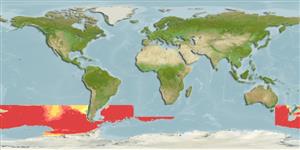>
Lophiiformes (Anglerfishes) >
Oneirodidae (Dreamers)
Etymology: Oneirodes: Greek, 'oneiros' = a dream or dreamlike or out of a dream (suggesting this fish is so strange and marvelous that can exist only in dreams) (Ref. 86949).
Environment: milieu / climate zone / depth range / distribution range
Ecologie
marien bathypelagisch; diepte 700 - 2000 m (Ref. 86949), usually 800 - 1100 m (Ref. 86949). Deep-water; 36°S - 77°S
Southern Ocean: sub-Antarctic and Antarctic waters.
Grootte / Gewicht / Leeftijd
Maturity: Lm ? range ? - ? cm
Max length : 15.0 cm SL (female)
Korte beschrijving
Determinatiesleutels | Morfologie | Morfometrie
Dorsale zachte stralen (totaal) : 5 - 7; Anale zachte stralen: 4. Characterized by having escal morphology: esca with a stout, internally pigmented appendage, usually bearing a compressed papilla and 2 tapering filaments on distal tip; several small tapering filaments along posterior margin of anterior escal appendage; papilla and filaments of anterior escal appendage unpigmented; rounded or truncated terminal escal papilla with a distal streak of pigment; unpigmented, unbranched tapering posterior escal appendage as long as or shorter than escal bulb; absence of lateral and anterolateral appendages; relatively short and broad subopercle, without indentation on posterodorsal margin; length of ventral fork of opercle 25.2-32.2% SL; ratio of lengths of the dorsal and ventral forks of opercle 0.52-0.59; absence of epibranchial teeth; presence of teeth on pharyngobranchial II; upper jaw teeth 20-37, lower jaw teeth 22-48; teeth on vomer 4-7; dorsal fin rays 5-7; anal fin rays 4; pectoral fin rays 17-19; head length 35.0-46.2% SL; head depth 36.3-48.8% SL; premaxilla length 25.0-35.0% SL; length of lower jaw 38.3-50.0% SL; length of illicium 19.1-28.3% SL (Ref. 86949).
Larvae are epipelagic, young and adults are mesopelagic or bathypelagic (Ref. 47377). Minimum depth from Ref. 58018.
Levenscyclus en paargedrag
Maturiteit | Voortplanting | Paaien | Eieren | Fecunditeit | Larven
Pietsch, T.W., 1990. Oneirodidae. p. 212-213. In O. Gon and P.C. Heemstra (eds.) Fishes of the Southern Ocean. J.L.B. Smith Institute of Ichthyology, Grahamstown, South Africa. (Ref. 5186)
Status op de Rode Lijst van het IUCN (Ref. 130435: Version 2024-1)
Gevaar voor de mens
Harmless
Gebruik door de mens
Visserij: van geen belang
Tools
Speciale rapporten
Download XML
Internetbronnen
Estimates based on models
Preferred temperature (Ref.
123201): 0.2 - 1.9, mean 1.3 °C (based on 19 cells).
Fylogenetische diversiteitsindex (Ref.
82804): PD
50 = 0.5000 [Uniqueness, from 0.5 = low to 2.0 = high].
Bayesian length-weight: a=0.01995 (0.00906 - 0.04395), b=3.01 (2.83 - 3.19), in cm total length, based on all LWR estimates for this body shape (Ref.
93245).
Trofisch niveau (Ref.
69278): 4.1 ±0.7 se; based on size and trophs of closest relatives
Weerstandsvermogen (Ref.
120179): Gemiddeld, minimale populatieverdubbelingstijd 1,4-4,4 jaar (Preliminary K or Fecundity.).
Fishing Vulnerability (Ref.
59153): Low vulnerability (10 of 100).
